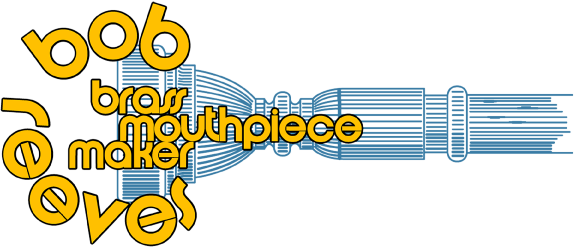Trumpet Mouthpiece Gap Adjustment
Let’s face it, the trumpet can be a beast sometimes — stuffy low notes, tight high notes, quirky notes that just don’t settle or play in tune. While there is no substitute for diligent practice, there are always ways to make the trumpet easier. Maybe even a lot easier! What if we told you that with this one simple trick, you could make one or more of the following improvements to your trumpet playing immediately:- better intonation
- more open feel
- better projection
- cleaner articulation
- more secure slotting
The Bob Reeves Brass Paper Trick
Here’s how to do the Bob Reeves Paper Trick yourself:- Take a sheet of paper and cut off a small piece. It should be about 3/4″ long and only about 1/8″ wide. Set the piece of paper aside.
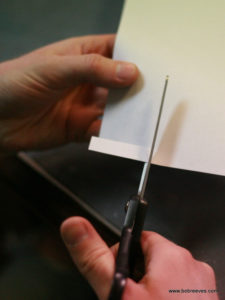
- Play an exercise that covers your comfortable range. It should include some articulation.
- Remove your mouthpiece and place the paper length-wise on the side of the shank of the mouthpiece.
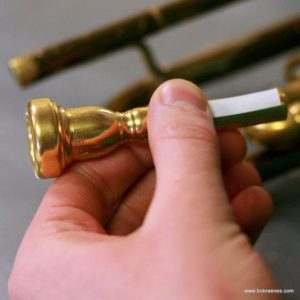
- Put the mouthpiece and the piece of paper into your trumpet receiver.
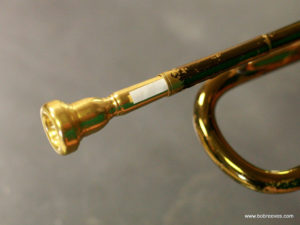
- Play the exercise again.
- Note what changes you hear in your sound, articulation, slotting, and feel.
“I’ve Done The Paper Trick – Now What?”
One of three things will happen:- It will play better with the paper.
- It will play worse with the paper.
- You won’t notice a difference.
How Does the Gap Work?
How can this simple trick improve your trumpet playing? The short answer is that it allows you to experiment by changing the gap between your mouthpiece and the leadpipe, which is an often neglected, yet crucial element of your playing setup. Some tips on doing The Paper Trick:- record yourself and listen back
- have someone else listen to you in front of the bell
- use the paper trick on all your mouthpiece and trumpet combinations
Paper Trick Video:
Exploring Deeper into the Trumpet Gap
If you would like to learn more about the gap, here are some additional blog posts you can read:“Hi, I play on a ABC mouthpiece on a XYZ model trumpet. What sleeve would give me the best gap.”Usually, our customers are shocked when our answer is a resounding, “I don’t know!” After all, Bob Reeves invented and patented the adjustable gap receiver and sleeve system 40 years ago. How the heck couldn’t we know? The answer is simple – we only know two of the three variables needed to determine the best gap and really, we don’t know any of the three variables unless we have your mouthpiece and trumpet here in the shop for analysis.
The Player-Trumpet-Mouthpiece System
It is critical to realize that there are three elements that must be analyzed in assessing your equipment – the trumpet, the mouthpiece, and you, the player. It seems silly, but most players forget the most important element – you!How The Gap Relates to the Player-Trumpet-Mouthpiece System
Think of the gap as a fine tuning device. It is a way to dial in your trumpet, with your mouthpiece, to the way you like to play. Let’s say we know the exact size of your trumpet mouthpiece shank and the receiver on your trumpet. There is still no way we (or anyone else in the world, for that matter) can know what you like to feel in your trumpet equipment.The Shoe Analogy
Think of it like shoes. Imagine you wear a size 9 shoe. Let’s go one step further and say you wear a 9 Wide shoe. I could send you 10 pairs of size 9W shoes and I would bet that some would feel more comfortable than others. In fact, I’d be willing to bet that there would be some shoes, despite being your measured size, will feel downright uncomfortable to walk around in. The best shoe salesman in the world cannot blindly tell you which brand will feel comfortable to you until you try them on.Put Yourself First!
Just like the shoe analogy above, only you know what feels comfortable to you. Put another way, no one can tell you what will work for you (if they do quickly run the other way!). So how do you find what works for you? Experiment. Our paper trick is a great way to discover what role the gap plays in your unique Player-Trumpet-Mouthpiece System. Experiment with the gap using the Bob Reeves Paper Trick!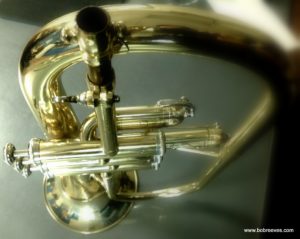 Does your flugelhorn mouthpiece wobble? Do you have problems with intonation, slotting or sound with your flugel?
Does your flugelhorn mouthpiece wobble? Do you have problems with intonation, slotting or sound with your flugel?
If you’ve ever played a flugelhorn for more than five minutes you’ve undoubtedly run into a problem involving shanks and receivers. No mouthpiece seems to play or fit correctly and you keep hearing about a “taper” that isn’t a taper — what is going on?
Don’t worry, help is here to bring you your beloved flugelhorn sound!
Types of Flugelhorn Mouthpiece Shanks
Though there are many manufacturers of flugelhorns today, there are only three commonly used flugelhorn shanks and one more that is very rare.
1) The Couesnon Flugelhorn Mouthpiece Shank (French Shank)
The first shank is referred to commonly as the “French Shank” or the “Couesnon Shank.” As you may have guessed, it was used originally on Couesnon flugelhorns. This shank is not a taper, as is used on other trumpet, cornet, or flugelhorn mouthpieces. The bottom inch or so of the mouthpiece shank is cylindrical. At that point the shank flairs slightly into a shoulder which secures the mouthpiece into the receiver. Some folks call this type of flugelhorn mouthpiece shank a French Taper or a Couesnon Taper, which is a misnomer since there is no taper to the shank.
French Shank mouthpieces will not fit properly in other types of flugelhorn receivers.
2) The Standard Flugelhorn Mouthpiece Shank
The second kind of flugelhorn mouthpiece shank is referred to as the “Standard Shank” or “Large Morse Taper.” Unlike the French Shank, the Standard Shank is a traditional taper similar to what you find on trumpets, cornets, and other brass instruments. Many flugelhorns are manufactured today, including Yamaha flugelhorns, that accept this taper.
Standard shank mouthpieces generally do not fit in a French Shank or the smaller Bach Shank receiver.
3) The Bach Flugelhorn Mouthpiece Shank
The third flugelhorn mouthpiece shank that is commonly used is the “Bach Shank” or “Small Morse Taper.” It is also a taper, but at a smaller size than the Standard Shank flugelhorn mouthpiece. It has been used on Bach flugelhorns since they were first produced.
4) Trumpet Shanked Flugelhorns
The last shank that very few flugelhorns accept is actually the same size that is used on trumpet mouthpieces. This setup is used on some European flugelhorns, but it is exceedingly rare.
“What Flugelhorn Mouthpiece Do I Need?”
When you are considering a flugelhorn or a flugelhorn mouthpiece, always check and double check that the parts you will be using will work together. Having an incompatible setup of mouthpiece and receiver will result mouthpieces not fitting properly and poor intonation and playability.
The “American Shank” Flugelhorn Mouthpiece
Depending on where you live and who you talk to, you may run across mentions of an American Shank flugelhorn. In our research, we have found that manufacturers and players can be referring either to #2 or #3 above when referring to “American Shanks.” Bach is one of the most prominent U.S. manufacturers and so some people refer to the Bach Shank as the American Shank. Nowadays, more U.S. manufacturers use the Standard Shank size so that has caused some folks to label the larger Standard Shank as the “American Shank.” To avoid confusion, it would be best to use Standard and Bach, or Large and Small Taper.
The Double Standard
Unfortunately, some people refer to either the Large or Small Shanks as “Standard.” This is because many years ago, the Bach Shank was considered the standard size. Over the last 40-50 years, however, the Large Shank has become much more popular while the Bach Shank waned. There has been a resurgence in the Bach Shank in recent years, though the Large taper size is still much more common.Looking To Improve Your Flugelhorn or Flugelhorn Mouthpiece?
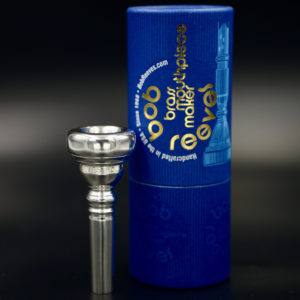 Bob Reeves Brass has a complete line of flugelhorn mouthpieces for all shank sizes of you are looking for a mouthpiece.
Bob Reeves Brass has a complete line of flugelhorn mouthpieces for all shank sizes of you are looking for a mouthpiece.
You might also consider getting a valve alignment for your flugelhorn to improve sound, intonation, and projection.
Flugelhorns Manufacturers Grouped by Mouthpiece Shank Type
Couesnon (No Taper): French Besson, Couesnon, Flip Oakes, Kanstul, Miraphone
Bach (Small Morse Taper): B & S, Bach, R, S, Berkeley, Besson, Courtois, Eclipse, F. E. Olds, Holton, LeBlanc, James , Trevor, Kanstul, Miraphone , Phaeton, Reynolds, Schilke, Selmer, Shiller, Taylor, Van Laar
Standard (Large Morse Taper): Adams, Benge, Blessing, Callet, Conn, Eclipse, Gerd Dowids, Getzen, Josef Lidl, Kanstul, King, Lawler, Miraphone , Orlando Wind Instruments, Stomvi, Thomas Inderbinen , Weril, Yamaha,
Trumpet Mouthpiece Taper: Gerd Dowids
